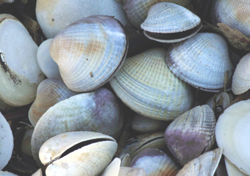Cockles
There are three tasks focusing on cockles: one looking at observations; one reading food chains; and one looking at relationships in a marine ecosystem.
Cockles live in sheltered coastal areas around New Zealand.

They are a very important food source in some marine ecosystems.

Cockles are an important link in the food web of organisms that live in the coastal waters of New Zealand. Imagine what would happen to the organisms of this food web if people took large numbers of cockles for themselves.
Questions 3 & 4 assesses your understanding of the interdependence of organisms in a food web.

Science capability: Gather and interpret data
| Question | Answer | |||||||||
|---|---|---|---|---|---|---|---|---|---|---|
| 1. Below are observations and inferences that scientists have made about cockles. Sort the statements into the correct boxes. |
|
|||||||||
| 2. In one food chain cockles eat phytoplankton and are eaten by seabirds, crabs and rock lobsters. Which food chain below shows this? |
|
|||||||||
|
3a). Which organisms in the food web will be immediately affected by a decrease in cockle numbers? |
crabs, phytoplankton, seabirds. | |||||||||
| 3b). Choose one organism that you said would be immediately affected and explain how it will be affected. |
Crabs and seabirds Crabs and seabirds eat cockles. A decrease in cockle numbers could reduce the food supply for the crabs and seabirds. With less cockles to eat crab and seabird numbers could decrease. Phytoplankton Cockles eat phytoplankton. If fewer cockles eat phytoplankton, the phytoplankton numbers could increase. |
|||||||||
|
4a). Which organisms in the food web will be affected in the long term by a decrease in cockle numbers? |
cod, crabs, shrimp, phytoplankton, bivalve molluscs, rock lobsters, zooplankton, seabirds. | |||||||||
| 4b). Choose one organism that you said would be affected in the long term and explain how it will be affected. |
All answers are correct. In the long term all the organisms in the food web could be affected in different ways e.g.,
Crabs, seabirds and cod
2. Fewer organisms feed on the phytoplankton
Phytoplankton, bivalve molluscs, zooplankton, shrimp, rock lobsters and cod and seabirds
3. Organisms could eat more of the other species.
Seabirds, cod, bivalve molluscs and shrimp, rock lobsters
|
|||||||||
|
Question
|
Problems/Misconceptions |
| 1. Sort the statements into observations or inferences. |
If students are struggling with this distinction go to the first capability in science capabilities for further activities.
|
| 2. Which food chain for the crab, cockle and phytoplankton is correct? |
Most of the students correctly answered this question. For those who answered it incorrectly the option below was selected most often.
Next steps: Discuss that the arrows go from producer to consumer because scientists wanted to show the direction of energy transfer and this was the convention they agreed on. |
|
3a). Which organisms in the food web will be immediately affected by a decrease in cockle numbers? 3b). Choose one that you said would be immediately affected and explain how it will be affected. |
Most of the students identified the seabirds and crabs, e.g., numbers would decrease. The phytoplankton which would increase in numbers was the least often identified.
Some students read a decrease in a species as the end of another [species that eat this species] e.g.,
Because the crabs have only eaten cockles so they would have died out so the cod won't have as much food
|
|
4a). Which organisms in the food web will be affected in the long term by a decrease in cockle numbers? 4b). Choose one organism that you said would be affected in the long term and explain how it will be affected. |
Most of the students correctly identified that any one of the species in the food web would be affected by a reduction in cockle numbers in the long term.
Some students made just one connection between their chosen organism and another species in the food web, e.g.,
Crabs [will be affected] because [cockles are] their main food source.
Zooplankton numbers will grow because phytoplankton [numbers] would grow.
Others made many connections between their chosen species and other species in the food web, e.g.,
Seabirds eat cockles. If there is less cockles they will eat more cod, but cod eats more bivalve molluscs and shrimp because there is less crab because there is less cockles. |
- making students aware that in a change that is detrimental for some species [e.g., decreasing their population], there can be a different effect for others, [e.g., a population increase]. Ask students to think about the possible long term effects on this population [e.g., pressure on food sources].
- research one of the organisms in the food web and list all the things they eat; and/or
- include another of their food sources into the food web with the connections to other organisms in the food web that also eat this food.



